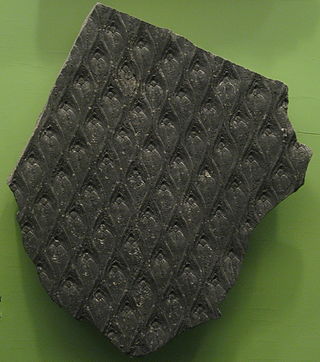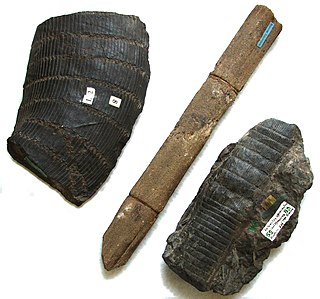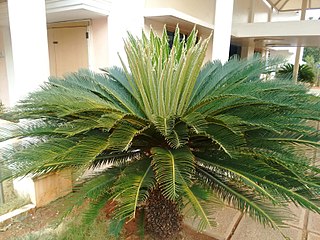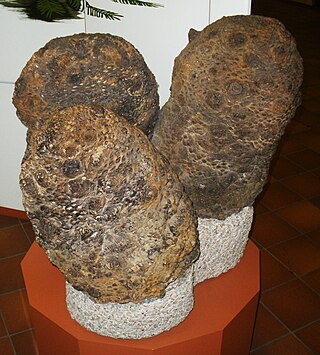
Cycads are seed plants that typically have a stout and woody (ligneous) trunk with a crown of large, hard, stiff, evergreen and (usually) pinnate leaves. The species are dioecious, that is, individual plants of a species are either male or female. Cycads vary in size from having trunks only a few centimeters to several meters tall. They typically grow very slowly and live very long. Because of their superficial resemblance, they are sometimes mistaken for palms or ferns, but they are not closely related to either group.

Lepidodendron is an extinct genus of primitive lycopodian vascular plants belonging the order Lepidodendrales. It is well preserved and common in the fossil record. Like other Lepidodendrales, species of Lepidodendron grew as large-tree-like plants in wetland coal forest environments. They sometimes reached heights of 50 metres, and the trunks were often over 1 m (3.3 ft) in diameter. They are often known as "scale trees", due to their bark having been covered in diamond shaped leaf-bases, from which leaves grew during earlier stages of growth. However, they are correctly defined as arborescent lycophytes. They thrived during the Carboniferous Period, and persisted until the end of the Permian around 252 million years ago. Sometimes erroneously called "giant club mosses", the genus was actually more closely related to modern quillworts than to modern club mosses. In the form classification system used in paleobotany, Lepidodendron is both used for the whole plant as well as specifically the stems and leaves.

Calamites is a genus of extinct arborescent (tree-like) horsetails to which the modern horsetails are closely related. Unlike their herbaceous modern cousins, these plants were medium-sized trees, growing to heights of 30–50 meters. They were components of the understories of coal swamps of the Carboniferous Period.

Cycas is a genus of cycad, and the only genus in the family Cycadaceae. About 113 species are accepted, which are native to the Indo-Pacific, East Africa and Madagascar. Cycas circinalis, a species endemic to India, was the first cycad species to be described in western literature, and is the type species of the genus. The best-known Cycas species is Cycas revoluta.

The Zamiaceae are a family of cycads that are superficially palm or fern-like. They are divided into two subfamilies with eight genera and about 150 species in the tropical and subtropical regions of Africa, Australia and North and South America.

Pteridospermatophyta, also called "pteridosperms" or "seed ferns" are a polyphyletic grouping of extinct seed-producing plants. The earliest fossil evidence for plants of this type are the lyginopterids of late Devonian age. They flourished particularly during the Carboniferous and Permian periods. Pteridosperms declined during the Mesozoic Era and had mostly disappeared by the end of the Cretaceous Period, though Komlopteris seem to have survived into Eocene times, based on fossil finds in Tasmania.

Bennettitales is an extinct order of seed plants that first appeared in the Permian period and became extinct in most areas toward the end of the Cretaceous. Bennettitales were amongst the most common seed plants of the Mesozoic, and had morphologies including shrub and cycad-like forms. The foliage of bennettitaleans is superficially nearly indistinguishable from that of cycads, but they are distinguished from cycads by their more complex flower-like reproductive organs, at least some of which were likely pollinated by insects.

Williamsonia is a genus of plant belonging to Bennettitales, an extinct order of seed plants. Within the form classification system used in paleobotany, Williamsonia is used to refer to female seed cones, which are associated with plants that also bore the male flower-like reproductive structure Weltrichia.

Dioon is a genus of cycads in the family Zamiaceae. It is native to Mexico and Central America. Their habitats include tropical forests, pine-oak forest, and dry hillsides, canyons and coastal dunes.

Cheirolepidiaceae is an extinct family of conifers. They first appeared in the Triassic, and were widespread during most of the Mesozoic era. They are united by the possession of a distinctive pollen type assigned to the form genus Classopollis. The name Frenelopsidaceae or "frenelopsids" has been used for a group of Cheirolepidiaceae with jointed stems, thick internode cuticles, sheathing leaf bases and reduced free leaf tips. The leaf morphology has been noted as being similar to that of halophyte Salicornia. Several members of the family appear to have been adapted for semi-arid and coastal settings, with a high tolerance of saline conditions. Cheirolepidiaceae disappeared from most regions of the world during the Cenomanian-Turonian stages of the Late Cretaceous, but reappeared in South America during the Maastrichtian, the final stage of the Cretaceous, increasing in abundance after the K-Pg extinction and being a prominent part of the regional flora during the Paleocene, before going extinct.

Tempskya is an extinct genus of tree fern that lived during the Cretaceous period. Fossils have been found across both the Northern and Southern hemispheres. The growth habit of Tempskaya was unlike that of any living fern or any other living plant, consisting of multiple conjoined dichotomous branching stems enmeshed within roots that formed a "false trunk".

Cycadeoidaceae is a family of bennettitalean plants which flourished in the Mesozoic era. Two genera, Cycadeoidea and Monanthesia, are currently recognised though most species are poorly known. They had a similar morphology to cycads, with thick, branchless trunks covered in scale leaves.
Monanthesia is an extinct genus of bennettitalean plant that is known from fossil finds in Europe and North America, which existed during the Early Cretaceous period.

This timeline of stegosaur research is a chronological listing of events in the history of paleontology focused on the stegosaurs, the iconic plate-backed, spike-tailed herbivorous eurypod dinosaurs that predominated during the Jurassic period. The first scientifically documented stegosaur remains were recovered from Early Cretaceous strata in England during the mid-19th century. However, they would not be recognized as a distinct group of dinosaurs until Othniel Charles Marsh described the new genus and species Stegosaurus armatus in 1877, which he regarded as the founding member of the Stegosauria. This new taxon originally included all armored dinosaurs. It was not until 1927 that Alfred Sherwood Romer implemented the modern use of the name Stegosauria as specifically pertaining to the plate-backed and spike-tailed dinosaurs.
This article contains papers in paleobotany that were published in 2016.
This article records new taxa of plants that are scheduled to be described during the year 2017, as well as other significant discoveries and events related to paleobotany that are scheduled to occur in the year 2017.

Ctenis is a genus of fossil foliage attributable to the Cycadales, being one of the most common genera of cycad fossil leaves in the Mesozoic.

Pterophyllum is an extinct form genus of leaves known from the Carnian to the Maastrichtian, belonging to the Bennettitales. It contains more than 50 species, and is mainly found in Eurasia and North America.
This paleobotany list records new fossil plant taxa that were to be described during the year 2012, as well as notes other significant paleobotany discoveries and events which occurred during 2012.
Taeniopteris is an extinct form genus of Mesozoic vascular plant leaves, perhaps representing those of cycads, bennettitaleans, or marattialean ferns. The form genus is almost certainly a polyphyletic category for unfertile leaves of a certain shape ("taeniopterids") which cannot be assigned to specific groups due to a lack of information on cuticle or spore structures. The leaves are simple, with a strong central vein (rhachis) and an unbroken margin. The central vein leads to nearly perpendicular lateral veins, which may be slightly divided or undivided. The shape of the leaf is variable, but often elongated and smooth-edged. "Taeniopterid" leaves with bennettitalean-type cuticle are placed in the form genus Nilssoniopteris, while those with cycad-type cuticle are placed within Nilssonia and related genera. Some fertile "taeniopterids" preserve spore packages, and can be assigned to marattialean ferns.
















